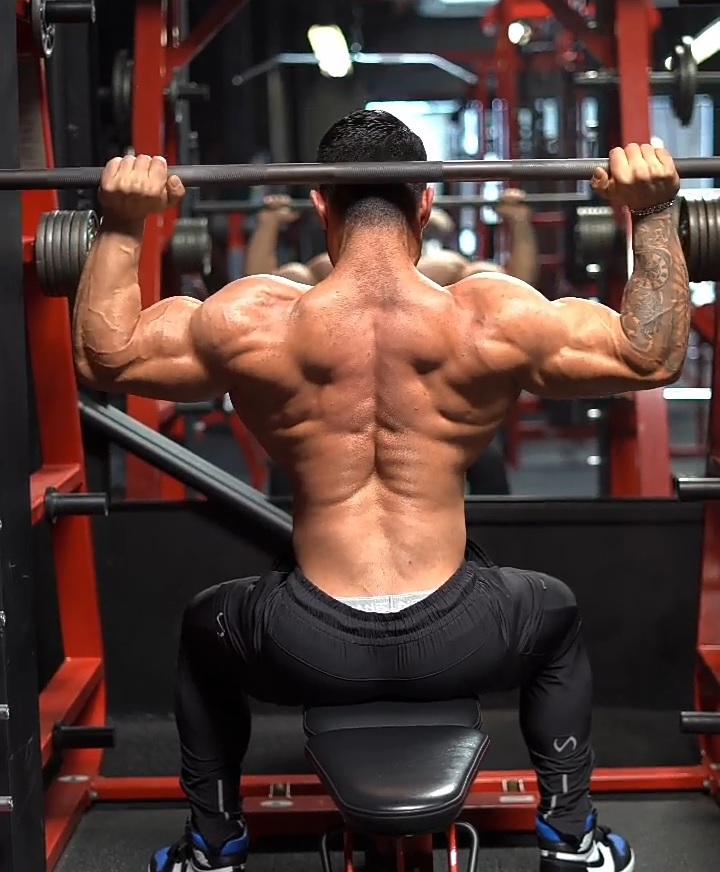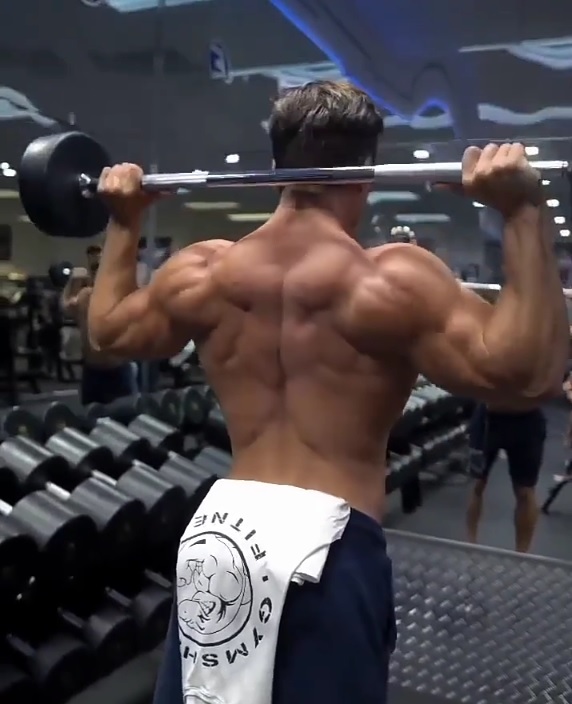The Behind-the-neck press, also known as the behind-the-neck overhead press, is a variation of the shoulder press that targets your shoulders.
What is the Behind-the-neck press?

The Behind-the-neck press is a barbell pressing exercise that involves a range of motion from behind the head, resting on the shoulders, all the way overhead. This exercise can be done in a sitting or standing position. The exercise demands good shoulder mobility and stability before it can be properly incorporated into your training program.
The Behind-the-neck press works the front, or trapezius, and rear deltoid (shoulders), traps or trapezius (upper back), triceps brachii (back upper arm), and serratus anterior (armpit above the rib cage). When done standing, the behind-the-neck press challenges your core and legs as well.
Working your shoulders, upper back and upper arms is a great way to improve upper body strength. It also enhances shoulder stability and mobility.
Strong shoulders allow you to perform a wide variety of movements, including of lifting, pulling, pushing, and punching. Additionally, good shoulder stability and mobility reduce your risk of shoulder pain and injury.
Many people first need to work on their thoracic spine (upper back) and shoulder mobility before being able to perform this exercise.
With enough mobility and strength, this movement can be an exceptional shoulder builder.
How to do the Behind-the-neck press
This exercise can be performed both sitting and standing.
The study compared muscle stimulation during overhead presses performed with passing the barbell in front or behind the head or using a shoulder press machine. Overhead presses are commonly performed to strengthen the muscles around the shoulders. However, several overhead press variations can be executed, thus varying the stimulation for each muscle. 1 2
This is how you will do both variations.
1. Seated Behind the Neck Shoulder Press

Sitting behind the neck shoulder press will help you focus on the barbell position and keep your shoulders from externally rotating. If you’re new to working out, a Smith machine can be a useful tool to help your body get used to the mechanics of movement.
Instructions
- Adjust the bar to just below shoulder height while standing, then load the desired weight on the bar.
- Place an adjustable bench under the bar in an upright position.
- Sit on the bench and pull down on the bar with an overhand grip.
- Inhale, brace yourself, tuck your chin in, then lower the bar to the nape of your neck.
- Exhale and push the bar back to lock.
- Repeat for the desired number of repetitions.
2. Standing Behind the Neck Shoulder Press

Standing behind the neck press variation is difficult and risky. Start with a very light bar or weight and give yourself some time to let your mind and body adjust to the trajectory of the bar and the overall feel of the exercise.
You won’t get any back support in this exercise, so you need to brace your core especially well. The lack of a bank makes the overall movement more unstable. Your body will recover from that slack.
Instructions
- Standing behind the neck press exercise is best done inside a squat rack to make it easier to lift the bar. To get started, first place the bar on a shelf that is appropriate for your height.
- Once the correct height is chosen and the bar is loaded, step under the bar and place the back of the shoulders (slightly below the neck) on top of it.
- Grasp the bar with both hands on each side and push off with your feet first to lift from the rack, straightening your torso.
- Using a moderate shoulder-width stance, step away from the rack and point your feet slightly out. While doing this exercise, your back should remain straight. This will be your starting position.
- As you exhale, lift the bar up by fully extending your arms.
- Hold the contraction for one second and inhale to lower the bar back to the starting position.
3. Tips
This is one of the most controversial exercises in the fitness industry because it can potentially put a lot of stress on your neck and shoulders.
If you’re new to the exercise, start with the seated version on a weight bench. You can also use a vertical back bench for added support.
While it is possible to exercise safely, it is not for everyone. Even advanced lifters should work with a personal trainer to stay safe.
Here are the following points to keep in mind while performing the move:
- Start practicing the move with a light, empty bar or, better yet, a hollow tube.
- Don’t grab the bar with too wide or too narrow a grip. Keep your elbows at 90 degrees to the bar.
- Elbows should be directly under the bar, not flared in or out.
- Do not give a sudden movement and when you lower the bar, below parallel, if the shoulder does not have enough mobility, do not force the bar down.
- If you feel a pinch in your shoulder even with an empty bar, then you might as well not do this move. So it’s not like too much weight is a problem on the behind the neck press. In reality, it is any weight that causes joint discomfort.
- Don’t do the movement as the first movement in your training program. Let the shoulders warm up properly.
- Keep the bar from reaching up to the neck.
- In case you have been performing this move for a long time, and you are sure of the same, then go ahead. But for beginners, or injury-prone guys and gals, just stop with the bar, slightly near the bottom position.
- If you have an injury or major discomfort doing the shoulder press, avoid the weights altogether. Try to do the movement with dumbbells.
Bottom line
There are several alternative exercises to the behind the neck barbell press that will work the same muscles and give you similar strength without the risk to your shoulder joints.
Front presses are performed similarly, but with the bar in front of your neck. You can also try the dumbbell shoulder press, which allows for a more personalized range of motion of the shoulders.
Bent-over lateral raises and upright rows will target the posterior deltoid fibers, while also giving your upper back a great workout.
A study in the Journal of Sport and Health Science compared overhead pressing techniques for the front of the head and the back of the neck.3
In 33 subjects who performed movements in the sitting position. Although differences were observed in the movement of the spine of men and women during the test, both front and back compression of the neck were found to be safe. When performed on subjects with normal trunk stability and ideal shoulder range of movement. Trunk stability is essential for stabilizing spinal posture, especially during the seated overhead press without back support.
The behind the neck bench press is primarily a shoulder exercise, but it also works many of the back muscles. This exercise primarily works the lateral and posterior fibers of the deltoid, as well as the trapezius, triceps and serratus anterior. To a lesser extent, the rhomboids, infraspinatus, teres minor, and supraspinatus are also used.
- Coratella Giuseppe, Tornatore Gianpaolo, Longo Stefano, Esposito Fabio, Cè Emiliano. “Front vs Back and Barbell vs Machine Overhead Press: An Electromyographic Analysis and Implications For Resistance Training,” Frontiers in Physiology. VOLUME-13. YEAR-2022. DOI: 10.3389/fphys.2022.825880. ISSN:1664-042X.[↩]
- Benjamin Jung; Beenish S. Bhutta. “Anatomy, Head and Neck, Neck Movements,” Treasure Island (FL): StatPearls Publishing; 2022 Jan.[↩]
- Mark R. McKean, Brendan J. Burkett. “Overhead shoulder press e In-front of the head or behind the head?,” Faculty of Science, Health, and Education, School of Health and Sport Sciences, University of the Sunshine Coast, Sippy Downs, Queensland 4556, Australia. doi: 10.1016/j.jshs.2013.11.007.[↩]














